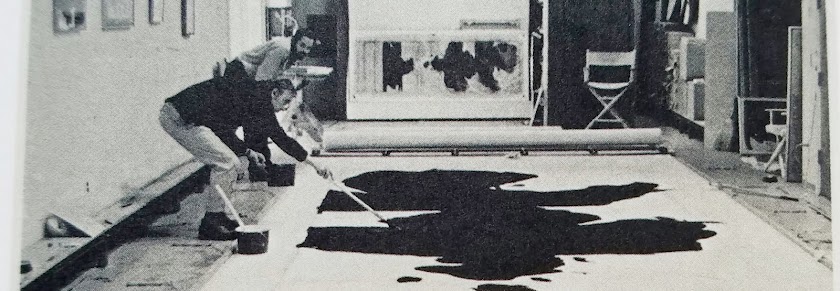"There is a catboat from the Adams and two Indian cayucas,
which carry thalassia grass used as fodder for the turtles."
 |
| The completed 'Thalassia' coat rack with base. |
I like to make a number of different designs; try it out on paper first. These cartoons are acrylic paintings on paper.
Once the drawing has been selected, the individual parts of the design must be segregated on paper. Each part has to be re-scaled individually and given a letter or number for identification.
The mock-up, upper left in photo, is now primed white in advance of 'colorization.' On the right are the big oak planks that will become legs for the final piece. All of these machines will make the planks straight and parallel.
Here are two oak legs being glued together with clamps. The two parts in front with pink bands are plywood templates traced from the oak legs. Templates will be useful if I ever decide to make another coat rack of this design. The areas where the leg parts overlap are painted pink. This color locates the parts for future assembly. Other templates express their overlaps in different colors; blue, green etc. So you know that it is correctly assembled when green-to-green, red-to-red etc. Believe it or not, there are a total of fifteen (15) separate pieces of wood that comprise this coat rack, not including the base.
One of the more interesting shapes is the eight inch wide 'spacer' between the front and rear sets of legs. Here it is shown having just been cut out of a two inch thick block of poplar. This spacer follows the "S" curve of the second leg in from the front.
There is the completed Douglas fir mock-up on the left. It has been painted in a manner that is faithful to the cartoon. But an extra leg (blade of 'grass') has been added in the rear. The white primed version on the right is made out of oak. The curves on this one have become more refined and somewhat 'slenderized.' Each has a total of ten (10) coat hooks. Three on the back are not shown in these photos.
The painted and clear coated 'Thalassia' mock-up has been purchased by Porter Briggs, a collector in Little Rock, AR. Porter is the founder and Chairman of A Briggs Passport & Visa Expeditors: http://www.abriggs.com/ The Briggs Washington, DC office obtained my visa to Southern China in 2010. Otherwise I would have had to wait in line for hours in NYC - with no guarantee of getting the visa!
This is how the design would look with single, solid (monochrome) colors:
This is the oak version primed for painting. The welded steel pan below was fabricated by Peter Kirkiles, also of Kent. The metal pan and wood base will be painted a cream color to match the client's bamboo flooring. Note that the wood 'spacer' has a slight curve on the top edge. This is to automatically center silk scarves that are draped over the spacer. The bottom of the spacer has a corresponding lower curve. That is where you place your hand to move the coat rack around the room. It is the center of gravity for the whole piece.
Up-Date:
This 'Thalassia' story will be re-posted with new photos when the
colors are completed. They will show the oak coat rack with three different transparent glazes; diarylide yellow, cobalt turquois and cobalt blue. It
is a lovely way to work. You slow down the drying to blend the colors. It's not a make-it-or-break-it process. If you don't like the result you can wipe it all off and start again. My glazes are made from Golden acrylic paints.
See new photos of Thalassia with the final glazes applied below.
A Glaswegian church decorator, John Canning,
taught me how to do these glazes. He would make his own paints from
pigments ground in oil. No Japan driers. Canning and his crew restored the ceiling at Grand Central Station some years ago; Battell Chapel stencils at Yale too. He and I painted the Equestrian Bench together; shown above on the banner for this blog.
I am trying to approximate the feeling of the sea as described in Matthiessen's Far Tortuga. The native fishermen are not concerned with useless abstract thoughts like reconciliation between man and nature. There is no literary nothing. They fish. The sea is beautiful. The sea is dangerous. They are only reconciled to their fates.
It may be impossible to use this subject as a motif for a coat rack. But it's worth a try. As Plato said, "The craftsman, looking toward the true form, so fashions."
3.22.13LR.jpg) |
| Front |
 |
| Rear |
3.22.13LR.jpg) |
| Side |
And here are two small tables below that I recently made. The polychrome one (on right) is in the spirit of the Thalassia coat rack. The natural wood table (left) is based on the early American 'birdcage' device; four columns as the transition from post to table top. We sometimes see this on early 'pie crust' tables that tilt up on a birdcage wood hinge. It was a great design scheme then - and still is! This one is fixed; does not tilt.
The top of the table on the right is made from the Thalassia glaze color test board shown below:
















